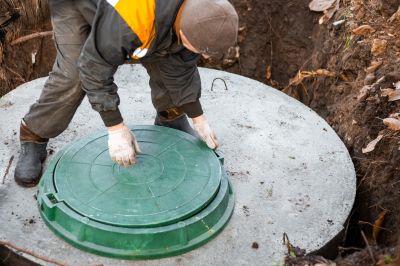Leading Equipment For Well And Septic System Evaluation
Equip yourself with top-performing tools that support comprehensive inspections and accurate system diagnostics.
 When it comes to ensuring the safety and functionality of well and septic systems, selecting the right inspection products is essential. Proper inspection tools can help identify potential issues early, saving time and preventing costly repairs. These products range from basic testing kits to advanced electronic devices that provide detailed insights into water quality and system integrity. Whether you are a homeowner conducting routine checks or a professional inspector, having reliable equipment is crucial for accurate assessments.
When it comes to ensuring the safety and functionality of well and septic systems, selecting the right inspection products is essential. Proper inspection tools can help identify potential issues early, saving time and preventing costly repairs. These products range from basic testing kits to advanced electronic devices that provide detailed insights into water quality and system integrity. Whether you are a homeowner conducting routine checks or a professional inspector, having reliable equipment is crucial for accurate assessments.
Top Overall Option
Comprehensive Well and Septic Inspection Kit
This all-in-one testing kit offers a range of test strips, reagents, and simple electronic tools designed for both well water analysis and septic system assessments. It provides detailed results for key parameters such as bacterial presence, pH, and chemical contaminants, making it suitable for homeowners and professionals alike. Its user-friendly design and comprehensive testing options make it a versatile choice for routine inspections.
Types of Products For Well And Septic Inspections
Water Testing Strips
Quick and easy strips to test for bacteria, pH, nitrates, and other common water quality indicators.
Liquid Test Reagents
Chemical reagents that provide visual color changes to identify specific contaminants or chemical levels in water.
Digital Water Testers
Electronic devices with digital displays that measure parameters such as pH, chlorine, and turbidity in water samples.
Septic Tank Level Indicators
Tools designed to measure sludge and scum levels within septic tanks to assess their condition.
Portable Inspection Cameras
Flexible, waterproof cameras that can navigate through pipes and tanks to visually inspect for blockages or damage.
Ultrasonic Tank Sensors
Sensors that use ultrasonic waves to determine the liquid level within septic tanks without contact.
Dye Testing Kits
Dyes used to trace leaks or flow paths within septic systems and plumbing.
Flow Meters
Devices that measure water flow rates to evaluate system performance.
Chemical Test Kits
Comprehensive kits for testing multiple chemical parameters in well water, including heavy metals and organic compounds.
Tank Inspection Mirrors
Mirrors designed to help view difficult-to-access areas within septic tanks or pipes.
Pressure Testing Devices
Tools to assess the pressure integrity of plumbing and septic system components.
Bacterial Testing Kits
Specialized kits to detect and quantify bacteria levels in water samples.
Popular Choices
Widely used for quick assessments of water safety and quality.
Common electronic devices for measuring pH and total dissolved solids in water samples.
Popular tools for monitoring septic tank health and scheduling maintenance.
Favored for their ease of use in locating obstructions or damage within pipes.
Trusted by professionals for comprehensive chemical testing in well water.
Increasingly used for contactless measurement of septic tank levels.
Popular for leak detection and flow tracing in septic systems.
Common in assessing system performance and ensuring proper flow.
Frequently used for rapid detection of bacterial contamination in water sources.
Helpful for visual inspections in tight or hard-to-see spaces.
Inspection products for wells often include water testing kits that analyze parameters such as pH levels, bacterial presence, and contaminant concentrations. These kits typically feature easy-to-use test strips or liquid reagents, making them accessible for non-professionals. For septic systems, inspection tools may involve sludge level indicators, dye testing supplies, and portable cameras that can navigate through pipes and tanks. These tools help determine the condition of the septic tank, identify blockages, or detect leaks.
Advanced electronic testing devices are also available, offering real-time data collection and analysis. These may include digital water testers with LCD displays, multi-parameter meters, and ultrasonic sensors for measuring tank depths. Such equipment provides precise readings and can streamline the inspection process, especially for professionals managing multiple properties or complex systems. Ensuring compatibility with existing systems and ease of use are important factors when choosing these tools.
Investing in quality inspection products not only aids in maintaining system health but also supports compliance with local regulations. Regular inspections using appropriate tools can help prevent environmental contamination and safeguard public health. With a wide array of products available, selecting the right tools tailored to specific needs can make the inspection process more efficient, thorough, and reliable.
Key Buying Considerations
- Type of inspection required: water quality testing, tank assessment, or leak detection.
- Ease of use: whether the product is suitable for non-professionals or requires specialized training.
- Accuracy and reliability of the results provided by the product.
- Compatibility with existing systems and inspection procedures.
- Portability and durability of the tools, especially for fieldwork.
- Range of parameters tested: some kits focus on bacteria and pH, while others analyze multiple chemical contaminants.
- Speed of obtaining results: rapid tests are useful for quick assessments, while detailed analysis may require lab testing.
- Cost and value for money, considering the scope of testing and features offered.
- Availability of consumables or replacement parts, such as test strips or reagents.
- Compliance with local regulations and standards for water and septic system inspections.
- Customer reviews and ratings to gauge real-world performance and satisfaction.
- Manufacturer support and availability of instructional resources or customer service.
- Sample collection methods and volume requirements for accurate testing.
- Environmental conditions in which the products will be used, such as outdoor or remote locations.
